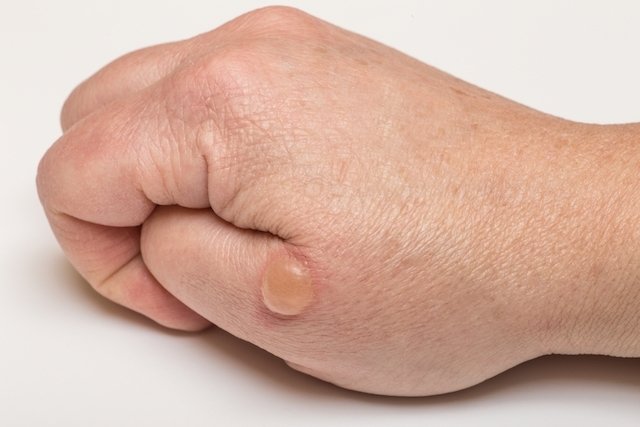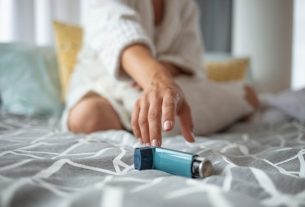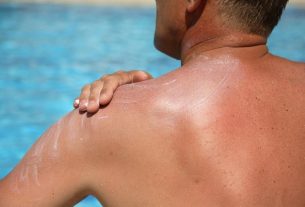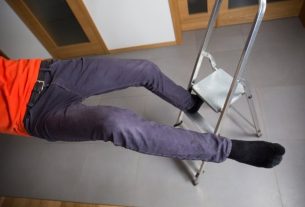2nd degree burn is the second most serious type of burn, which affects the deepest layers of the skin, causing symptoms such as intense pain, redness and blisters on the skin, which should not be popped to prevent the entry of microorganisms that could cause infection.
This degree of burn can be caused by chemical, thermal or electrical agents, and is very painful, as it can cause destruction of nerve endings, hair follicles or glands.
In most cases, 2nd degree burns can be treated at home with the application of cold water and burn ointments, however, if it causes very intense pain or is larger than 1 hand, it is recommended to go to the emergency room immediately.

How to recognize 2nd degree burn
The main characteristics that help to recognize a 2nd degree burn are:
- Bubble in place;
- Intense pain;
- Redness or darkening of the skin;
- Moist and shiny skin;
- Detachment of skin layers;
- Very painful wound at the site when the blister bursts.
Second-degree burns are more common in domestic accidents, due to contact with boiling water or oil, contact with hot surfaces such as a stove, or direct contact with fire.
What is the healing time?
The healing time for a 2nd degree burn usually takes between 2 to 3 weeks, but it can vary according to the size of the burn and the affected region of the body.
After healing, a 2nd degree burn may leave a lighter stain for superficial burns or a scar for deeper burns.
First aid for burns
First aid for a 2nd degree burn includes:
- Remove contact with the heat source immediately. If your clothes are on fire, you should roll on the floor until the fire stops and you should never run or cover your clothes with blankets. If clothing is stuck to your skin, you should not try to remove it at home, as this could worsen skin injuries. You should go to the hospital to have it removed by a healthcare professional;
- Place the area under running water, with a gentle jet, for at least 20 minutes or until the skin stops burning, as it helps to reduce pain and swelling, as well as preventing the burn from becoming more serious. It is not recommended to put very cold water or ice on the area, as this can aggravate the skin injury;
- Soak a sterile pad or clean cloth in saline or cold water and cover the affected area. This helps reduce pain during the first few hours.
After removing the wet tissue, you can apply a burn ointment, as it helps keep the pain controlled and stimulates skin healing. See examples of burn ointments that can be used.
What not to do
At no point should the burn blister be burst, as this increases the risk of infections, which can worsen recovery and even affect healing, making antibiotic treatment necessary. If necessary, the blister should only be drained in the hospital, by the doctor, using sterilized material.
Furthermore, alcohol, sugar, coffee grounds, butter, oil, olive oil, toothpaste or any other substance should not be applied to the burn, in addition to it being important not to touch the area, not to remove detached layers of skin and not to remove any foreign object that is in the burn.
When to go to the emergency room
The person should be taken to the emergency room if the burn is larger than the size of the palm of one hand or affects large areas of the body.
In addition, you should seek emergency help in cases of burns to the head, face, neck, palms of the hands, soles of the feet, groin, thighs, knees, wrists or buttocks, as these are areas with a greater risk of infection, or when the burn was caused by electricity or chemicals.
In the case of babies, children and the elderly, any type of burn needs to be evaluated by a doctor, so they should be taken to the emergency room immediately.
What to do to treat a 2nd degree burn
For minor burns, which occur when touching an iron or a hot pan, for example, treatment can be done at home. But in larger burns, when part of the face, head, neck, or areas such as arms or legs are affected, treatment must always be indicated by the doctor because it involves an assessment of the victim’s entire health status.
For small 2nd degree burns, you can bandage it using healing ointment and then cover it with gauze and bandage it with a bandage, for example. Check out how to make a bandage for each degree of burn.
In case of large burns, it is advised that the person stays hospitalized for a few days or weeks until the tissues are well healed and the person can be discharged.
Normally, in extensive 2nd and 3rd degree burns, hospitalization is prolonged, requiring the use of medication, serum for rehydration, an adapted diet and physiotherapy until complete recovery. See how 3rd degree burns are treated.
Bibliography
- GREENHALGH, D. G. Management of Burns. N Engl J Med. 380. 24; 2349-2359, 2019
- BURGESS, M.; et al. The Immune and Regenerative Response to Burn Injury. Cells. 11. 19; 3073, 2022
- BRITISH RED CROSS. Learn first aid for someone who has a burn. Disponível em: <https://www.redcross.org.uk/first-aid/learn-first-aid/burns>. Acesso em 27 jun 2023
- WARBY, R.; MAANI, CV IN: STATPEARLS (INTERNET). TREASURE ISLAND (FL): STATPEARLS PUBLISHING. Burn Classification. 2022. Available at: <https://www.ncbi.nlm.nih.gov/books/NBK539773/>. Accessed on June 27, 2023
- NHS. Burns and scalds. Available at: <https://www.nhs.uk/conditions/burns-and-scalds/>. Accessed on November 26, 2020
- UWHEALTH. Burn Care Guidelines for 2nd & 3rd Degree Burns. 2019. Available at: <https://www.uwhealth.org/healthfacts/wound-skin/4573.pdf>. Accessed on November 26, 2020
- BAPTISTA, Nelson T. First aid manual. 3rd ed. Sintra: National Fire School, 2018.
- VALE, Everton C. S. First care for burns: the dermatologist’s approach. An Bras Dermatol. Vol 80. 1 ed; 9-19, 2005

Sign up for our newsletter and stay up to date with exclusive news
that can transform your routine!
Warning: Undefined array key "title" in /home/storelat/public_html/wp-content/plugins/link-whisper-premium/templates/frontend/related-posts.php on line 12
Warning: Undefined array key "title_tag" in /home/storelat/public_html/wp-content/plugins/link-whisper-premium/templates/frontend/related-posts.php on line 13



